

Abdominal Computed Tomography in the Emergency Room: Overuse of Medical Technologies and the Depreciation of Clinical Diagnosis. Untitled. Association Between Inpatient Echocardiography Use and Outcomes in Adult Patients With Acute Myocardial Infarction. - PubMed - NCBI. Thyroid Cancer in Ecuador, a 16 years population-based analysis (2001–2016) Jamanetwork. Key Points Question What were the trends in medical imaging from 2000 through 2016 in the United States and Ontario, Canada?
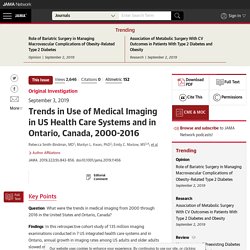
Jamanetwork. Key Points Question Did effect sizes for group-level differences between individuals with autism and control individuals decrease during past decades?
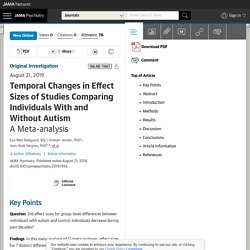
Findings In this meta-analysis of 11 meta-analyses, effect sizes for 7 distinct differences between groups with autism and control groups decreased over time, with 5 of 7 being statistically significant. Meaning The findings suggest that differences between individuals with autism and those without autism have decreased over time, which may be associated with changes in diagnostic practices.
Bmj.l4258. John P H Wilding, professor of medicine1, Vicki Mooney, executive director2, Richard Pile, general practitioner with special interest in cardiology3Author affiliations Categorising obesity as a disease will encourage people to seek treatment say John P H Wilding and Vicki Mooney,but Richard Pile thinks medicalisation would be disempowering and reduce motivation Excess accumulation of body fat (obesity) develops because of abnormal biological regulation of energy balance, has multiple complications, and should be considered a disease.
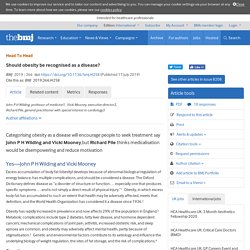
The Oxford Dictionary defines disease as “a disorder of structure or function . . . especially one that produces specific symptoms . . . and is not simply a direct result of physical injury.”1 Obesity, in which excess body fat has accumulated to such an extent that health may be adversely affected, meets that definition, and the World Health Organization has considered it a disease since 1936.2. Measuring the frequency and variation of unnecessary care across Canada. - PubMed - NCBI. Bmj. Jamanetwork. Untitled. Screening for Suicide Risk in Adolescents and Adults in Primary Care. Many doctors have distorted perceptions of the value of medical tests. In 2014, the Canadian Task Force on Preventive Health Care recommended against the prostate-specific antigen (PSA) test used to screen for prostate cancer in healthy men, concluding that it results in substantial harms via biopsies and surgeries that can lead to infections, impotence or urinary incontinence, and does not save men’s lives.
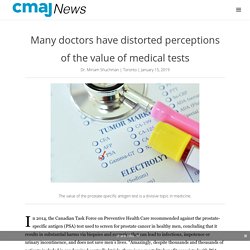
“Amazingly, despite thousands and thousands of patients included in randomized controlled trials, there is no mortality benefit associated with PSA testing, not a sliver,” said task force member Dr. Eddy Lang, head of emergency medicine at the University of Calgary. The task force urged doctors who offer the PSA test to discuss its “unclear benefits and substantial harms” with patients, rather than simply presenting it as a tool for cancer screening. A few years later, a survey of family doctors in the Barrie region of Ontario discovered that the task force recommendations barely affected clinical practice.
Against Diagnosis. What the Doctor Ordered: Improving the Use and Value of Laboratory Testing. Potentially serious incidental findings on brain and body magnetic resonance imaging of apparently asymptomatic adults: systematic review and meta-... - PubMed - NCBI. Bmj. Increased trend of unnecessary use of radiological diagnostic modalities in Pakistan: radiologists perspective. A Profusion of Diagnoses. That’s Good and Bad. I recently cared for a hairdresser who had gone through a year of vague and varied symptoms.
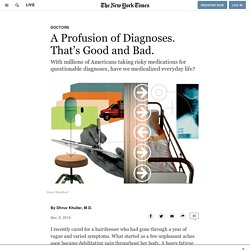
What started as a few unpleasant aches soon became debilitating pain throughout her body. A heavy fatigue settled into her bones: Holding scissors or sweeping the floor became too much. She slept fitfully; her memory flagged. Frustrated by many symptoms and few answers, she grew anxious and depressed. Our medical team, after a battery of unrevealing tests, settled on a diagnosis of fibromyalgia. s12959-018-0180-6. Prevalence and outcomes of incidental imaging findings: umbrella review. - PubMed - NCBI. Is “chronic kidney disease” a disease? - Smart - 2018 - Journal of Evaluation in Clinical Practice.
Overutilization of Health Care Resources for Breast Pain. - PubMed - NCBI. Incremental Benefits and Harms of the 2017 American College of Cardiology/American Heart Association High Blood Pressure Guideline. - PubMed - NCBI. Cervical Cancer Incidence in Young U.S. Females After Human Papillomavirus Vaccine Introduction. - PubMed - NCBI. Screening for Atrial Fibrillation Comes With Many Snags. The association of atrial fibrillation (AF) with an increased risk of stroke and heart failure makes it a serious health condition.

Many people have AF and do not know it, and its prevalence continues to rise in parallel with the growing numbers of people living with obesity and cardiac risk factors.1,2 These elements, along with the proliferation of devices capable of monitoring the heart rhythm, have led many physicians to promote screening for AF.3 The hypothesis is that early detection would allow treatment with anticoagulation, which would then deliver a net clinical benefit. Screening, however, is not a sure win.
Screening for Cardiovascular Disease Risk With Electrocardiography: US Preventive Services Task Force Recommendation Statement. - PubMed - NCBI. NEJM Journal Watch: Summaries of and commentary on original medical and scientific articles from key medical journals. Could mental health apps lead to overdiagnosis? There are tens of thousands of commercially available mental health apps on the market, many hugely popular.
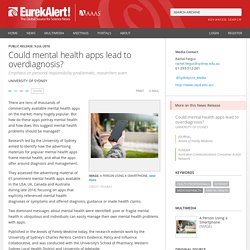
But how do these apps portray mental health and how does this suggest mental health problems should be managed? Research led by the University of Sydney aimed to identify how the advertising materials for popular mental health apps frame mental health, and what the apps offer around diagnosis and management. They assessed the advertising material of 61 prominent mental health apps available in the USA, UK, Canada and Australia during late 2016, focusing on apps that explicitly referenced mental health diagnoses or symptoms and offered diagnosis, guidance or made health claims. The Frequency of Unnecessary Testing in Hospitalized Patients - The American Journal of Medicine. Prompting during rounds decreases lab utilization in patients nearing discharge. Variability in diagnostic error rates of 10 MRI centers performing lumbar spine MRI examinations on the same patient within a 3-week period - The Spine Journal. Thirty-second atrial fib threshold may drive overdiagnosis.
Imaging for low back pain: is clinical use consistent with guidelines? A systematic review and meta-analysis - The Spine Journal. Clinical Usefulness of Imaging and Blood Cultures in Cellulitis Evaluation. Too much medicine: overdiagnosis and overtreatment of non-alcoholic fatty liver disease - The Lancet Gastroenterology & Hepatology. New blood pressure guidelines may make millions anxious that they're at risk of heart disease. Recent recommendations to lower the threshold for diagnosing patients with high blood pressure are likely to harm up to 80% of those newly diagnosed.
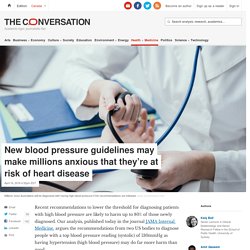
Our analysis, published today in the journal JAMA Internal Medicine, argues the recommendations from two US bodies to diagnose people with a top blood pressure reading (systolic) of 130mmHg as having hypertension (high blood pressure) may do far more harm than good. Previously, a person would be diagnosed as having hypertension if their systolic reading was 140mmHg or more. But late last year, the American College of Cardiology and the American Heart Association recommended lowering the threshold to 130mmHg.
High blood pressure is only one risk factor for heart disease and stroke. Other factors such as age, gender, smoking and diabetes also contribute to the overall risk profile. 'Kidney age', not kidney disease. There should be a rethink in how doctors talk to some patients with reduced kidney health, replacing the term 'chronic kidney disease' (CKD) with different bands of kidney age, according to a group of experts writing in the Canadian Medical Association Journal.
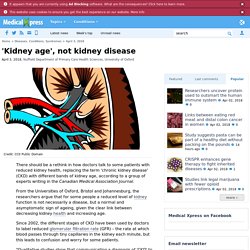
From the Universities of Oxford, Bristol and Johannesburg, the researchers argue that for some people a reduced level of kidney function is not necessarily a disease, but a normal and asymptomatic sign of ageing, given the clear link between decreasing kidney health and increasing age. Since 2002, the different stages of CKD have been used by doctors to label reduced glomerular filtration rate (GFR) – the rate at which blood passes through tiny capillaries in the kidney each minute, but this leads to confusion and worry for some patients. CKD stage 5 (where the filtration rate falls below 15 ml/min/1.73m2) is classed as disease at any age, since the kidneys no longer function and dialysis is required. Open.bmj. Parents want children to be labelled autistic. One of my former trainees, now an experienced consultant child psychiatrist, shocked me with an admission recently: ‘You will never believe how things have changed,’ he said.

‘I’d say 75 per cent of the kids I see have either got ADHD or they are on the autistic spectrum.’ There was no doubt in his mind about this, but I saw things a different way. ‘Surely not,’ I told him. Cmaj. Yes we scan: MUN doctors say too many CT scans being done in N.L. - Newfoundland & Labrador. A team of Memorial University doctors says too many unnecessary CT scans are being done in Newfoundland and Labrador, and patients should be worried about the health impacts. Dr. Pat Parfrey, clinical director of Choosing Wisely Newfoundland and Labrador — a provincial branch of a national campaign to cut down on unnecessary medical tests and procedures — said Monday that more than 100,000 scans are done in the province every year.
The rate of tests done — about 219 per 1,000 people — is the highest in the country, and about 47 per cent higher than the Canadian average of 149 per 1,000 people. Performing an unnecessary scan isn't just a case of better safe than sorry, he said, because of the radiation involved in the test. Dr. "There is radiation risk predisposing to cancer," Parfrey told CBC's Central Morning.
Too much medicine: overdiagnosis and overtreatment of non-alcoholic fatty liver disease. - PubMed - NCBI. Attitudes Regarding Overuse of Inpatient Laboratory Testing. Routine hospital laboratory testing is common, and unnecessary tests can harm patients.1 Multiple professional societies have recommended against routine laboratory testing in hospitalized patients.2 Advanced practice health care providers (APP), including nurse practitioners (NP), and physician assistants (PA), increasingly care for hospitalized patients and order tests3; registered nurses (RN) may also influence ordering.
To our knowledge, no studies have evaluated attitudes of nonphysician health care providers toward inpatient laboratory testing. Jamanetwork. Routine daily laboratory testing of hospitalized patients reflects a wasteful clinical practice that threatens the value of health care. Choosing Wisely initiatives from numerous professional societies have identified repetitive laboratory testing in the face of clinical stability as low value care. Although laboratory expenditure often represents less than 5% of most hospital budgets, the impact is far-reaching given that laboratory tests influence nearly 60% to 70% of all medical decisions.
Excessive phlebotomy can lead to hospital-acquired anemia, increased costs, and unnecessary downstream testing and procedures. Glaucoma. Skin Cancers Rise, Along With Questionable Treatments. (F)utility of computed tomography of the chest in the presence of pleural effusion : Pleura and Peritoneum. Imaging studies play a pivotal role in the diagnosis and management of pleural disease, and chest CT is frequently used to investigate thoracic pathologies because of its cross-sectional perspective and superior contrast resolution [13] and is often considered the gold standard as it is better at differentiating pleural from parenchymal disease [14]. However, the non-contrast chest CT in the presence of pleural effusion often confirms pleural effusion and shows the underlying collapsed lung and rarely provides additional information [15] over chest X-ray.
In our study, 47 of 49 (95.9 %) non-contrast studies did not provide a clinically significant or relevant finding beyond a chest X-ray that would have helped clarify the underlying process. Overdiagnosis and disease labels: the case of polycystic ovary syndrome. Dvances in medical technology make it easier to detect disease earlier than ever. That’s a good thing when it means a deadly cancer can be caught promptly and stopped with treatment. But it isn’t so good for people who are labeled with a disease that has mild symptoms, if any, and only a low risk of getting worse.
Such a diagnosis may do more harm than good, especially if the diagnosis adds an emotional burden and doesn’t change an individual’s treatment. Take polycystic ovary syndrome, also known as PCOS, one of several overdiagnosed conditions we study. Symptoms of this hormonal and metabolic disorder include menstrual irregularities, not ovulating during a menstrual cycle, the presence of polycystic ovaries (enlarged ovaries that contain numerous small follicles that contain immature eggs) and signs such as acne and excess facial and body hair that the body is producing too much testosterone and other androgens.
Advertisement. U.S. Trends in Undiagnosed Diabetes. Glucose Self-monitoring in Non-Insulin-Treated Patients With Type 2 Diabetes in Primary Care Settings: A Randomized Trial. - PubMed - NCBI. Calling an Ordinary Health Problem a Disease Leads to Bigger Problems - The New York Times. Gastroesophageal reflux disease (GERD) is different. Children with GERD have symptoms so severe that it degrades their life. It’s rare. But over time, more and more babies with reflux were labeled as having a “disease.” When technology creates uncertainty: pulse oximetry and overdiagnosis of hypoxaemia in bronchiolitis. Ricardo A Quinonez, associate professor (clinical) and section chief1, Eric R Coon, assistant professor (clinical)2, Alan R Schroeder, associate professor (clinical) and associate chief for research3, Virginia A Moyer, vice president, maintenance of certification and quality4Author affiliationsCorrespondence to: RA Quinonez raquinon@texaschildrens.org.
CBC (Confusing Broad Check) for Screening: Tools for Practice - Don't do screening CBC! Old, cheaper heart test as effective as newer, pricier ones. An old, cheaper test for heart disease is just as effective as newer, costlier ones, Ontario researchers have found. Their work, published Thursday in the Journal of the American Heart Association, suggests that health systems could save money by using the decades-old exercise stress test as a first-line diagnostic tool to identify coronary artery disease.
New diagnostic tests: more harm than good. Bjørn Hofmann, professor1, H. Gilbert Welch, professor2Author affiliationsCorrespondence to B Hofmann b.m.hofmann@medisin.uio.no Although new diagnostics may advance the time of diagnoses in selected patients, they will increase the frequency of false alarms, overdiagnosis, and overtreatment in others. Bjorn Hofmann and H. Electrocardiograms in Low-Risk Patients Undergoing An Annual Health Examination. Diagnosis creep: the new problem in medicine - MJA InSight 20, 29 May 2017. IN 2003, new European guidelines on preventing heart disease drastically lowered the blood pressure threshold for antihypertensive treatment.
Risk and disease. The pre-diabetes tidal wave - harbinger of doom or symptom of an overdiagnosis epidemic? Last updated 05:00, April 15 2017 With obesity rates soaring, fans of the prediabetes label hope they can shock people into lifestyle change, preventing an epidemic of diabetes. On the numbers, a quarter of adult Kiwis have it. And that's about where the consensus ends.
Controversies in diagnosis and management of community-acquired pneumonia. Too many patients get liver tests they don't need, which can raise fears and costs. Frequency of and variation in low-value care in primary care: a retrospective cohort study. + Author Affiliations Correspondence to: Sacha Bhatia, sacha.bhatia@wchospital.ca Abstract.
Reevaluation of Diagnosis in Adults With Physician-Diagnosed Asthma. The “Rainbow” of Extra Blood Tubes—Useful or Wasteful Practice? Dealing with uncertainty in a time of plenty. AHA: Unnecessary Stress Testing Still Alive And Kicking? Pre-diabetes: can prevention come too soon? - Evidently Cochrane. Why most health checkups are a scam meant to convert healthy people into patients. Overdiagnosis of heart failure in primary care: a cross-sectional study. Are we causing anemia by ordering unnecessary blood tests? : Cleveland Clinic Journal of Medicine. What are the risks of overtreating the many to help the few? Lowering the Bar: Medicine in the 21st Century. Medicalization and overdiagnosis: different but alike.
What Everyone Should Know about Lab Tests. Order your own lab tests. What could go wrong? Medicalization: Current Concept and Future Directions in a Bionic Society. The psychological harms of screening: the evidence we have versus the evidence we need. Inappropriate repeats of 6 common tests in a Canadian city. Overuse of Testing in Preoperative Evaluation and Syncope: A Survey of HospitalistsOveruse of Testing in Preoperative Evaluation and Syncope. Derivation and validation of a clinical decision rule to identify young children with skull fracture following isolated head trauma. Screening for cardiovascular disease risk factors beginning in childhood. Study Suggests Autism Is Being Overdiagnosed. Stress Testing in the Emergency Room: Not Which test but whether any test should be done. Who should receive bone mineral density testing? C Difficile Overdiagnosis ACP: Hospitalist Weekly - 16 September 2015.
Chronic Kidney Disease Can Be Dubious Diagnosis. Screening for type 2 diabetes mellitus: a systematic review for the U.S. Preventive Services Task Force. Evidence-Based Guidelines to Determine Follow-up Intervals: A Call for Action. Urinalysis Orders Among Patients Admitted to the General Medicine Service. Prevalence of over-/misdiagnosis of asthma in patients referred to an allergy clinic.
The overtreatment of 'mild' hypertension is causing more harm than good, say experts. Overdiagnosis of bone fragility in the quest to prevent hip fracture. After Nearly A Decade Of Rapid Growth, Use And Complexity Of Imaging Declined, 2008–14. We Are Giving Ourselves Cancer. Patients vent frustrations over MRI waits they say increase suffering. Toward a comprehensive management strategy for incidental findings in imaging.
The Risks of Overusing CT Scans. Initiative to Reduce Unnecessary Radiation Exposure from Medical Imaging > Appropriate Use. Use of Diagnostic Imaging Studies and Associated Radiation Exposure for Patients Enrolled in Large Integrated Health Care Systems, 1996-2010.